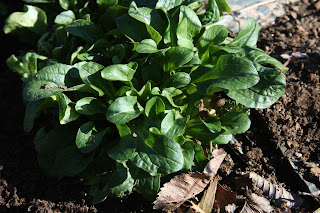Mache and Arugula = harvesting now from outside beds
Mache and Arugula leaves are abundant enough for a few salads a week at this time of year.
Seeds planted in the fall, thrive in our cold winter weather, growing through snow though ice will slow or completely stop them.
Mache or lamb's lettuce, has been cultivated in France since the 17th century. Mache's agreeable winter-growth habit make it an ideal source of folate, vitamin C, A, K. Iron, and fiber.
When I first started growing Mache, it was called Corn Salad, Field Lettuce. For travelers it is German Feldsalat and Netherlands veld salade and in France Valerianella locusta.
Fedco offers Mache seeds as 3102VC Verte de Cambrai Mâche. Fedco says "May be the same variety Thomas Jefferson grew in 1810 under the name Candia."
I scatter seeds in the fall during fall vegetable garden cleanup but here is a thorough explanation of how to grow Mache or Corn Salad for your winter table. http://www.vegetablegardener.com/item/4614/how-to-grow-mache-corn-salad-springs-first-green
Arugula on the other hand is spicy and an acquired taste if you have not eaten many greens other than lettuce or head cabbage. Arugula is often called Rocket. It has it has folates, phytochemicals, anti-oxidants, vitamins (A, B complex, C and K), and minerals .
Popular in Europe for hundreds of years, Arugula's many names include rugola, rucola, roquette, garden rocket, Mediterranean rocket, salad rocket, Roman rocket, or Italian cress and French roquette).
Pick the leaves young, because Arugula can become bitter tasting when it is about to set seed.
At http://schreibersfarm.com/arugula.html I learned that, "In Roman times Arugula was grown for both it's leaves and the seed. The seed was used for flavoring oils. On another interesting note, Rocket or Arugula seed has been used as an ingredient in aphrodisiac concoctions dating back to the first century, AD. (Cambridge World History of Food).
Part of a typical Roman meal was to offer a salad of greens, frequently Arugula (spelled Arugola), romaine, chicory, mallow and lavender and seasoned with a "cheese sauce for lettuce"
Mache is mild and sweet - easy to use with your favorite salad toppings.
Arugula can stand up for itself and recipes can help. Try these http://www.seasonalchef.com/recipe0106c.htm
Seeds planted in the fall, thrive in our cold winter weather, growing through snow though ice will slow or completely stop them.
Mache or lamb's lettuce, has been cultivated in France since the 17th century. Mache's agreeable winter-growth habit make it an ideal source of folate, vitamin C, A, K. Iron, and fiber.
 |
| Mache in the garden Feb 2013 |
Fedco offers Mache seeds as 3102VC Verte de Cambrai Mâche. Fedco says "May be the same variety Thomas Jefferson grew in 1810 under the name Candia."
I scatter seeds in the fall during fall vegetable garden cleanup but here is a thorough explanation of how to grow Mache or Corn Salad for your winter table. http://www.vegetablegardener.com/item/4614/how-to-grow-mache-corn-salad-springs-first-green
Arugula on the other hand is spicy and an acquired taste if you have not eaten many greens other than lettuce or head cabbage. Arugula is often called Rocket. It has it has folates, phytochemicals, anti-oxidants, vitamins (A, B complex, C and K), and minerals .
 |
| Arugula in my garden Feb 2013 |
Popular in Europe for hundreds of years, Arugula's many names include rugola, rucola, roquette, garden rocket, Mediterranean rocket, salad rocket, Roman rocket, or Italian cress and French roquette).
Pick the leaves young, because Arugula can become bitter tasting when it is about to set seed.
At http://schreibersfarm.com/arugula.html I learned that, "In Roman times Arugula was grown for both it's leaves and the seed. The seed was used for flavoring oils. On another interesting note, Rocket or Arugula seed has been used as an ingredient in aphrodisiac concoctions dating back to the first century, AD. (Cambridge World History of Food).
Mache is mild and sweet - easy to use with your favorite salad toppings.
Arugula can stand up for itself and recipes can help. Try these http://www.seasonalchef.com/recipe0106c.htm


Comments
Try the seeds - plant in the fall for winter harvest.